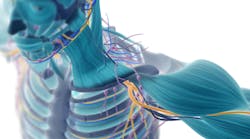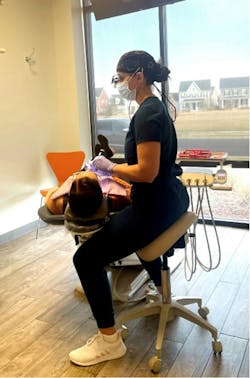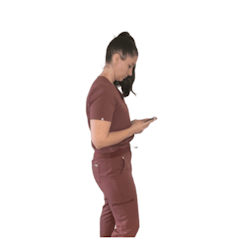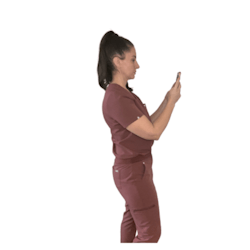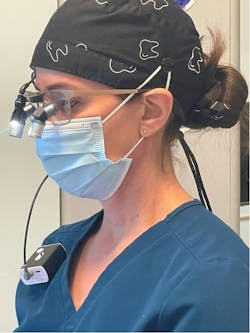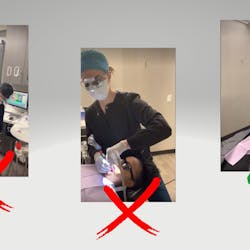It’s no secret that dental hygiene is a great career. Dental hygienists have high earning potential, good working hours, and are in demand. According to U.S. News & World Report, dental hygiene ranked number three on the best health care support jobs in 2023. This was due to a high median wage, low unemployment rate, and demand is predicted to increase over the next 10 years.1
It’s also no secret—to those working in the field, at least—that practicing dental hygiene can take a toll on the body, affecting the musculoskeletal system in various and sometimes extreme ways. According to a report by Business Insider in 2019, titled “The 32 most dangerous jobs for your health,” dental hygiene came in third, after dental lab technicians and dentists. This is due to exposure to disease and infection and time spent sitting.2
Another study revealed that hygienists are prone to injury because they spend long periods in static, awkward positions.3 Many hygienists work in a forward head position, looking at their patients with their heads forward and down. Additionally, there is a tendency to adopt a forward head position when using devices such as cell phones and laptops.
Why neutral head position is so important
Ideally, hygienists and the population at large should be in a neutral head position. This is easy to imagine from the profile view. The ear aligns with the shoulder, indicating a neutral cervical spine position (figure 1).
This allows the spine to support the head, with minimal soft tissue strain.4 It is best to allow the hard tissue of the spine and vertebrae to support the head, as they are thick and hard and don’t fatigue. Unfortunately, many hygienists do not practice this way; instead, their ear is out in front of their shoulder, resulting in a forward head position. The spine no longer supports the weight of the head; in this case, the soft tissue (muscles, ligaments, and tendons) of the neck and back strain to support the head. This has been shown to contribute to kyphosis, breathing issues, neck and back pain, and headaches, just to name a few.
Lifestyle habits and their effects on ergonomics
There are other lifestyle habits that contribute to a forward position in addition to practicing dental hygiene. It has been estimated the average American spends over four hours a day on their cell phone.5 Individuals are often not in a neutral head position when using their cell phones either; instead, many are hunched forward and down, looking at the screen (figure 2).
In addition, many adults utilize laptops and tablets, further promoting a forward head position. Even driving posture should be considered. Many adults drive with their shoulders raised and heads pushed out in front of them (figure 3).
Add up all these hours of seeing patients, on screens, and driving, and neck problems are on the horizon if the posture is not corrected.
Techniques to improve posture
Learning what a neutral neck position is and what it feels like will help one maintain it throughout the day. One technique used is an exercise called the cervical retraction. Performing this will get the head into an upright, neutral position. The ear will be in line with the shoulder, indicating the cervical spine is supporting the head.
Body awareness and reminding oneself to maintain neutral is very important when establishing this habit. Every time a hygienist moves during an appointment, they can reestablish neutral to cement the habit. When using a cell phone, the elbows can be flexed to bring the phone closer to the face, enabling the user to view the screen without tipping their head forward (figure 4).
When driving, remembering to keep the head up and back, even establishing contact with the headrest will help promote a neutral head position while driving.
Ergonomic loupes can help
Practicing dental hygiene can seem impossible when maintaining a neutral head position. Body awareness combined with truly ergonomic equipment will make this a possibility. Utilizing ergonomic deflection loupes will ensure keeping a neutral head position. These loupes are engineered to allow the user to see directly in the patient’s mouth without having to tip the head forward (figure 5).
These can be used when scaling, performing injections, oral cancer screenings, and can be used in any clock position.
Pain and disability rates among dental hygienists are surprisingly high, but this does not have to be a by-product of practicing hygiene. Learning ergonomics, such as maintaining a neutral head position and investing in ergonomic equipment, will ensure the comfort and longevity of the dental hygienist’s career. Being mindful of head position out of the operatory, such as when driving and using cell phones, will further protect the neck. Dental hygiene can be a long, fulfilling career without unnecessary pain and injury.
Editor's note: This article appeared in the April/May 2024 print edition of RDH magazine. Dental hygienists in North America are eligible for a complimentary print subscription. Sign up here.
References
- Comizio C. Best health care support jobs. US News & World Report. 2023. https://money.usnews.com/careers/best-jobs/rankings/best-health-care-support-jobs
- Kiersz A. The 32 most dangerous jobs for your health. Business Insider. March 19, 2019. https://www.businessinsider.com/most-dangerous-jobs-for-your-health-2019-3
- Hayes M, Cockrell D, Smith DR. A systematic review of musculoskeletal disorders among dental professionals. Int J Dent Hyg. 2009;7(3):159-165. doi:10.1111/j.1601-5037.2009.00395.x
- Valachi B. Practice Dentistry Pain-Free. Posturedontics Press; 2008.
- Payton LT. Americans check their phones 144 times a day. Here’s how to cut back. July 19, 2023. Fortune Well. https://fortune.com/well/2023/07/19/how-to-cut-back-screen-time/
Stephanie Botts, BSDH, RDH, CEAS, has been a clinical dental hygienist for over 15 years. She is a certified ergonomics assessment specialist providing both in-office and virtual ergonomics consulting and coaching to dental professionals. She also provides CE to dental and dental hygiene associations on ergonomics. Stephanie believes that by learning effective strategies to optimize proper ergonomics, dental professionals can practice pain-free and ensure career longevity. She can be reached at polishedposture.net or on Instagram at @steph.polishedposture.
